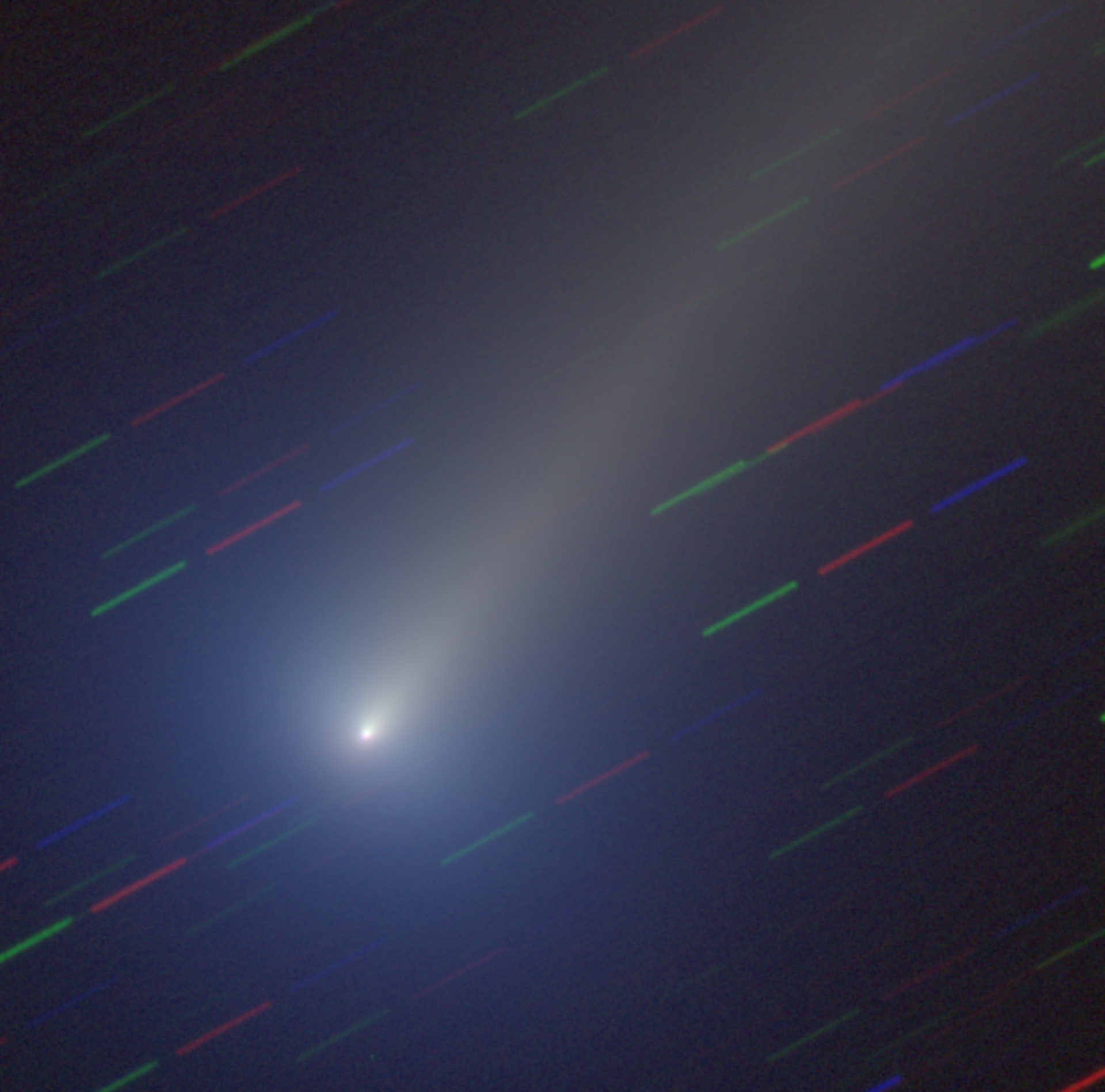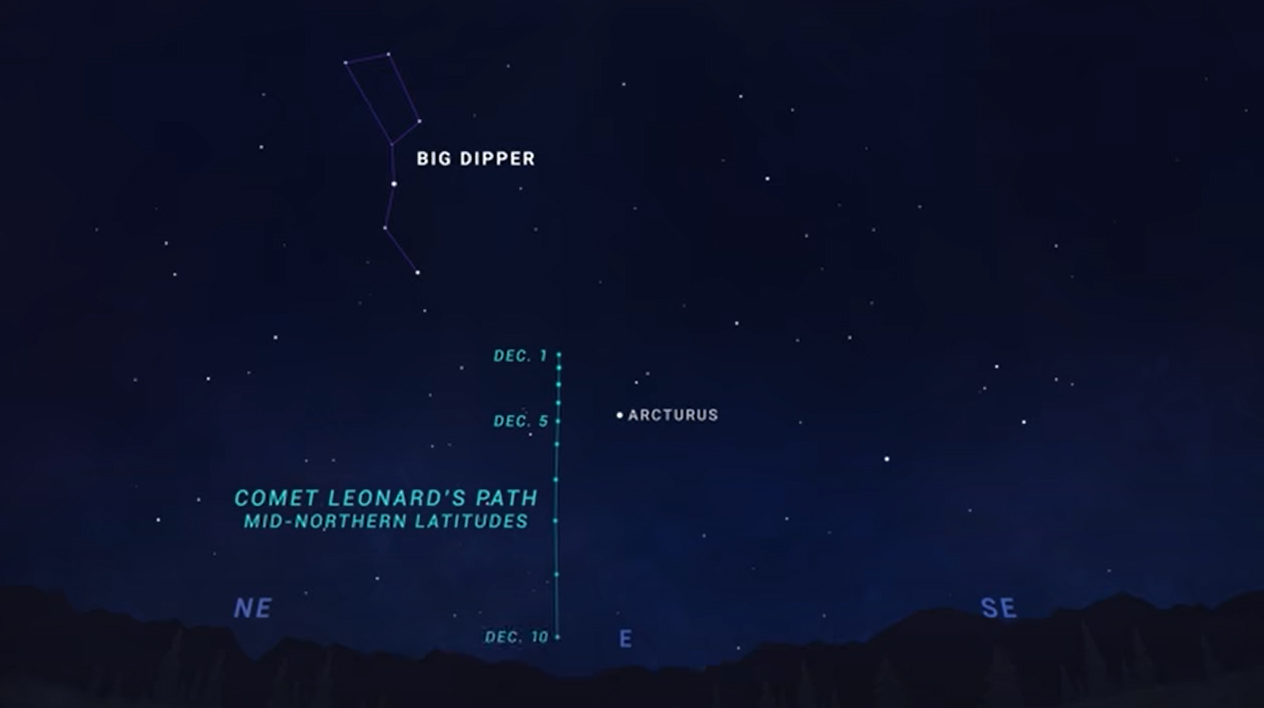Comet Leonard, the brightest of the year, is fading and acting strange
Comet Leonard is not brightening like scientists thought it would.

Something strange is happening to skywatchers' most anticipated comet of the year.
Astronomers first spotted what's been dubbed Comet Leonard in January 2021, and soon skywatchers were eagerly anticipating December and January, when the comet was due to pass by first Earth, then the sun. But by late November, observers noticed something strange. The comet should be getting brighter as it approaches the sun — and it is, but apparently only because it's getting closer to Earth, not because it's becoming inherently brighter.
Instead, it seems to be fading.
"It's not great news. The comet should be brighter and brighter," Quanzhi Ye, an astronomer at the University of Maryland who specializes in comets, told Space.com. "If it's not getting brighter then something's wrong, but we don't know exactly what at this stage."
Want to see Comet Leonard? Here's our telescope and binoculars recommendations
Based on what they've seen from previous comets, scientists worry that Comet Leonard's strange dimming means the iceball may be doomed. In the past, some comets that have broken apart have faded even as they fly closer to the sun — it's been the first sign that something is happening.
"Why it's fading, there are all kinds of hypotheses," Ye said. "The simplest and the most obvious one is something unhealthy is happening to the comet."
Get the Space.com Newsletter
Breaking space news, the latest updates on rocket launches, skywatching events and more!
The most likely hypothesis, he said, is that Comet Leonard is already splitting up, or it will begin to do so soon. But other factors could be to blame. For example, the comet could simply be running out of ice for the sun to vaporize, although Ye thinks that's unlikely. "It seems to be too coincidental," he said.
Nevertheless, it's too early to call Comet Leonard a goner.
"The images I've seen from this morning [Dec. 7], the comet still seems to be OK — morphologically it looks fine. But the intrinsically fading trend is still continuing," Ye said. "Time will tell, we don't know at this point."
Comet Leonard is a great target for amateur astronomers in December's night sky and if you're looking for a telescope of binoculars to objects like it, check out our guide for the best binoculars deals and the best telescope deals on right now. Our best cameras for astrophotography and best lenses for astrophotography guides also have tips on how to pick the best imaging gear to snap photos.

Ye said that the first sign a comet is doomed is that it loses its ion tail, a stream of charged particles pointing from the comet in the direction opposite the sun. That feature could disappear within a few hours of a comet breaking apart.
Comet Leonard makes its closest approach to Earth on Sunday (Dec. 12); its perihelion, or closest approach to the sun, comes on Jan. 3. Although the sun's influence will ease up after Jan. 3, the comet isn't necessarily safe even if it survives that long.
"Comets do all sorts of weird things," Ye said. "Sometimes they disintegrate before reaching perihelion, sometimes after, and there are even hypotheses saying that comets can disintegrate when they're farther out from the sun. So we won't know until we see it happen."
There are several factors that could break apart a comet, Ye noted. The gravitational tug of the sun or a large planet could pull it apart, sure, but the comet's heart could also implode. If the comet's material vaporizes in quite the right way, it could speed up the comet's spin so dramatically that the iceball flies to pieces.
And if Comet Leonard does break apart, scientists may never know what was the culprit. "Usually for individual comets it's hard to determine which is the dominant driver," Ye said.
Should skywatchers panic?

Even if Comet Leonard is meeting an early end, there's still time to see it in the skies. There's typically a delay between when a comet begins to break apart and when it fades as seen from Earth, Ye said.
"Usually it will take a few days before you can see the comet dramatically change and fade and stuff," he said. "We should be still in for something pretty bright next week, simply because it takes time for the comet to fully disintegrate."

Comet Leonard will be visible in the late mornings as it approaches Earth through Dec. 12. Then, it will disappear for a few days, hidden by the sun's glare, before gracing the evening skies by Dec. 17. For more details on spotting Comet Leonard, visit our skywatching guide.
Ye said he hasn't been able to see Comet Leonard yet because of cloudy weather, but hopes to next week. While he's interested in what comets can tell scientists about the early days of the solar system, he appreciates the display just as much.
"They're fun to watch and for bright comets they're beautiful," he said. "It's great to see them in the night sky."
Editor's Note: If you snap an amazing Comet Leonard photo and would like to share it with Space.com's readers, send your photos, comments and your name and location to spacephotos@space.com.
Email Meghan Bartels at mbartels@space.com or follow her on Twitter @meghanbartels. Follow us on Twitter @Spacedotcom and on Facebook.
Join our Space Forums to keep talking space on the latest missions, night sky and more! And if you have a news tip, correction or comment, let us know at: community@space.com.

Meghan is a senior writer at Space.com and has more than five years' experience as a science journalist based in New York City. She joined Space.com in July 2018, with previous writing published in outlets including Newsweek and Audubon. Meghan earned an MA in science journalism from New York University and a BA in classics from Georgetown University, and in her free time she enjoys reading and visiting museums. Follow her on Twitter at @meghanbartels.









